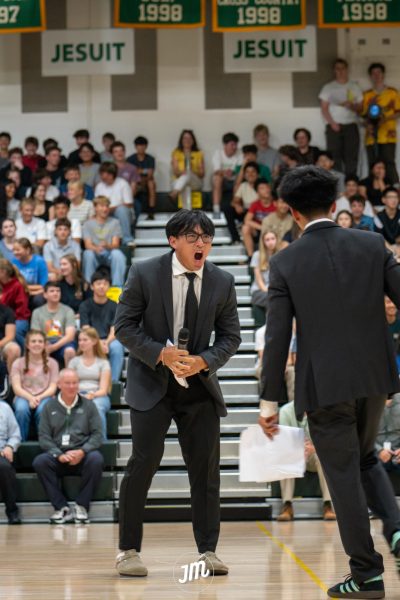Clarifying how Jesuit Addresses Race Curriculum
Students actively participating and engaging in a lively class discussion.
Recent discussions have sparked conversations between Jesuit students about Critical Race Theory and Catholic Social Teaching. The Jesuit Chronicle is interested in clarifying the difference between the two for the student body.
Defining CRT
Critical Race Theory (CRT) is a framework of legal analysis grounded in the idea that race is a social construct used to oppress and take advantage of people of color (Britannica). It examines how racism is ingrained in the law and how it perpetuates inequalities between dominant white groups and people of color. Through this framework, CRT’s purpose is to eradicate racial hierarchies in society by challenging white privilege and exposing the covert usage of racism in society’s language, values, and principles (Americanbar).
CRT officially began in 1989, but has academic roots in the 60s and 70s (Britannica). It developed from Critical Legal Studies (CLS) which argued that the law preserved unjust racial hierarchies.
Where CRT diverges from CLS is in its perception of how the law perpetuates racial inequalities. CRT’s framework does not align with CLS’s approach of eliminating social injustice by undermining the law. CRT scholars believe that the law could be beneficial in improving and acquiring racial equality for people of color as much as oppressing and exploiting people of color, which is how scholars of CRT believe it is currently being used (Americanbar).
The framework of CRT is outlined into basic tenets which function as the foundational beliefs of the theory. The following tenets of CRT were taken from The American Bar Association.
- Recognition that race is not biologically real but is socially constructed and socially significant. It recognizes that science (as demonstrated in the Human Genome Project) refutes the idea of biological racial differences. According to scholars Richard Delgado and Jean Stefancic, race is the product of social thought and is not connected to biological reality.
- Acknowledgement that racism is a normal feature of society and is embedded within systems and institutions, like the legal system, that replicate racial inequality. This dismisses the idea that racist incidents are aberrations but instead are manifestations of structural and systemic racism.
- Rejection of popular understandings about racism, such as arguments that confine racism to a few “bad apples.” CRT recognizes that racism is codified in law, embedded in structures, and woven into public policy. CRT rejects claims of meritocracy or “colorblindness.” CRT recognizes that it is the systemic nature of racism that bears primary responsibility for reproducing racial inequality
- Recognition of the relevance of people’s everyday lives to scholarship. This includes embracing the lived experiences of people of color, including those preserved through storytelling, and rejecting deficit-informed research that excludes the epistemologies of people of color.
In an email addressing education curriculum, Jesuit President Tom Arndorfer clarified what framework Jesuit teachers follow: Catholic Social Teaching(CST).
“Jesuit High School does not teach Critical Race Theory,” said Mr. Arndorfer. “As a Catholic, Jesuit work sponsored by the Society of Jesus, our approach to teaching young people is based on the Holy Gospels, the Universal Apostolic Preferences, and Catholic Social Teaching. We align our curriculum and programs with these Catholic principles that guide all Jesuit works and that focus on human dignity, walking with the marginalized and vulnerable, and caring for the whole person and our common home.”
Defining CST
Catholic Social Teaching (CST) reflects Catholic doctrine concerning matters of human life and dignity. It is rooted in God’s teachings which express a commitment to love and justice. Jesuit High School is sponsored by the Society of Jesus, so Jesuit’s curriculum is grounded in CST, a tradition which interlaces various academic disciplines under the mission of “building a just society and living lives of holiness amidst the challenges of modern society” (usccb).
Amanda Montez, Director of Diversity, Equity, and Inclusion, defines CST as the writings of religious leaders who examined patterns in the gospel.
“It’s the writing of bishops and popes, past and present, about the trends they see throughout the gospel,” Montez said. “It’s thinking about life and dignity of the human person is the biggest one.”
CST is broken down into seven key themes which form the core of the Catholic social tradition. The following themes were taken from usccb,
- Life and Dignity of the Human Person: The Catholic Church proclaims that human life is sacred and that the dignity of the human person is the foundation of a moral vision for society. This belief is the foundation of all the principles of our social teaching. In our society, human life is under direct attack from abortion and euthanasia. The value of human life is being threatened by cloning, embryonic stem cell research, and the use of the death penalty. The intentional targeting of civilians in war or terrorist attacks is always wrong. Catholic teaching also calls on us to work to avoid war. Nations must protect the right to life by finding increasingly effective ways to prevent conflicts and resolve them by peaceful means. We believe that every person is precious, that people are more important than things, and that the measure of every institution is whether it threatens or enhances the life and dignity of the human person.
- Call to Family, Community, and Participation: The person is not only sacred but also social. How we organize our society — in economics and politics, in law and policy — directly affects human dignity and the capacity of individuals to grow in community.
- Rights and Responsibilities: The Catholic tradition teaches that human dignity can be protected and a healthy community can be achieved only if human rights are protected and responsibilities are met. Therefore, every person has a fundamental right to life and a right to those things required for human decency. Corresponding to these rights are duties and responsibilities–to one another, to our families, and to the larger society.
- Option for the Poor and Vulnerable: A basic moral test is how our most vulnerable members are faring. In a society marred by deepening divisions between rich and poor, our tradition recalls the story of the Last Judgment (Mt 25:31-46) and instructs us to put the needs of the poor and vulnerable first.
- The Dignity of Work and the Rights of Workers: The economy must serve people, not the other way around. Work is more than a way to make a living; it is a form of continuing participation in God’s creation. If the dignity of work is to be protected, then the basic rights of workers must be respected–the right to productive work, to decent and fair wages, to the organization and joining of unions, to private property, and to economic initiative.
- Solidarity: We are one human family whatever our national, racial, ethnic, economic, and ideological differences. We are our brothers and sisters keepers, wherever they may be. Loving our neighbor has global dimensions in a shrinking world. At the core of the virtue of solidarity is the pursuit of justice and peace. Pope Paul VI taught that if you want peace, work for justice.1 The Gospel calls us to be peacemakers. Our love for all our sisters and brothers demands that we promote peace in a world surrounded by violence and conflict.
- Care for God’s Creation: We show our respect for the Creator by our stewardship of creation. Care for the earth is not just an Earth Day slogan, it is a requirement of our faith. We are called to protect people and the planet, living our faith in relationship with all of God’s creation. This environmental challenge has fundamental moral and ethical dimensions that cannot be ignored.
Using CST to Talk about Race in the Jesuit Classroom
Malia Bernards, Chair of the History Department, detailed how CST helps facilitate conversations around race.
“Catholic Social Teaching advocates for human rights (dignity of all people) regardless of national, racial, ethnic, economic, and ideological differences,” Bernards said. “It further asserts that we are all part of one human family and one earth. Acknowledging these ideas provides a good starting place for discussions around race because it reminds us of our shared humanity. It can be a very important unifying point and helps provide some common ground.”
Peace and Justice teacher Matthew Schulte explained how CST drives the themes of the Peace and Justice course for juniors and seniors.
“[CST] consists of 7 principles, and they all have something to do with upholding the dignity of people,” Schulte said. ”It’s the side of the faith that interacts with the lives of people in the day to day. CST is how we are protecting the most vulnerable people among us, how we ensure that the rights of people are being upheld by society and that life is being dignified.”
Themes such as discrimination, redlining, and houselessness are other topics discussed in the course but that are looked at from a CST lens.
The Peace and Justice course cites the use of studying “scriptural and theological justice principles” which are applied to a better understanding of world issues. According to the Jesuit course catalog,
“After an overview of scriptural and theological justice principles, students will be guided through an educational process of context, social analysis, theological reflection, and pastoral action. These tools will then be applied to such issues as poverty, discrimination, homelessness, just-war theory, pacifism, and other issues of human rights. Jesus Christ’s call.”
Mrs. Bernards emphasized the intent of the History Department to provide more engaging and multifaceted discussions around race using a critical lens grounded in CST.
“We are currently working on ways to develop and empower individual student voices by incorporating written and reflective activities, creating opportunities for small or large group sharing and teaching students to dialogue for a deeper understanding of a topic (as opposed to a debate where we are trying to prove right or wrong with evidence),” Bernards said. “We teach critical debate for some topics and dialogue skills for others. Being able to dialogue respectfully, listen to one another and honor another person’s experience are essential skills in a democratic society and foundational to discussions about race.”
It is evident that Jesuit’s curriculum and programming are rooted in “love, care, and compassion” for all under Catholic Social Teaching.










